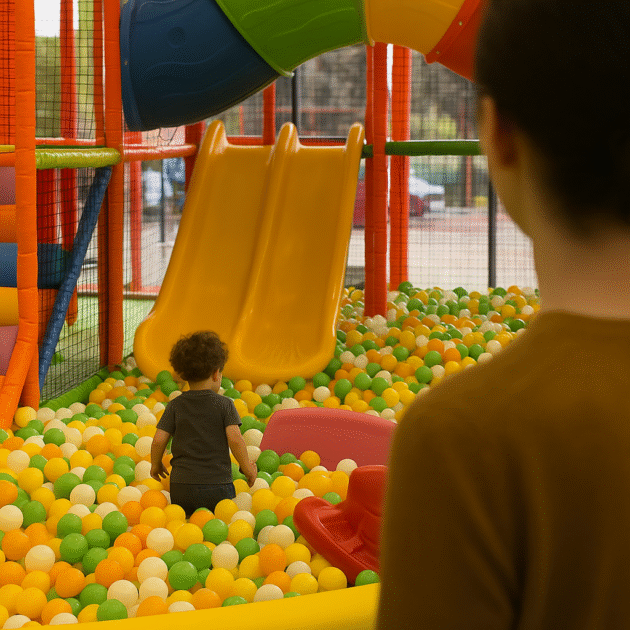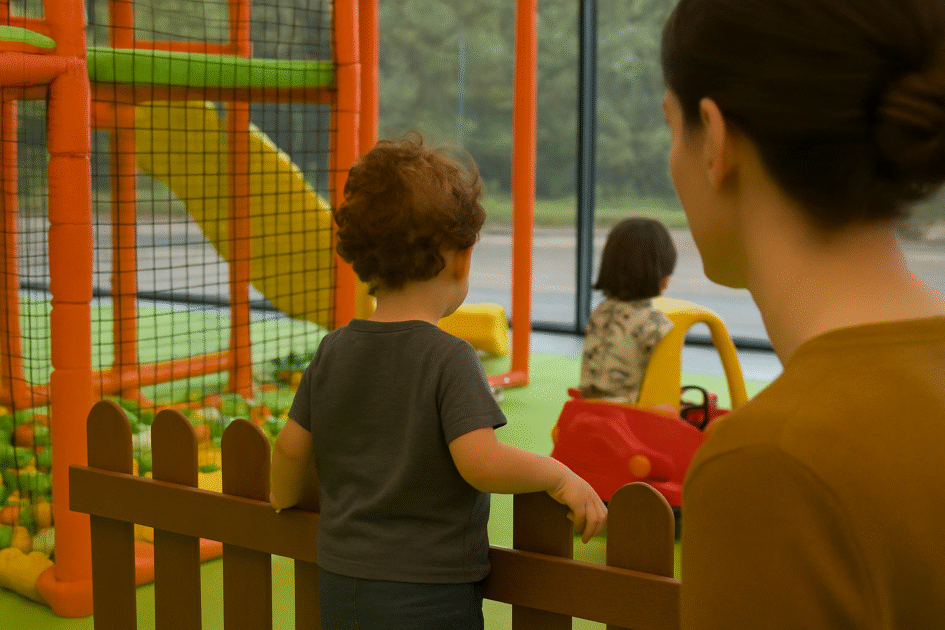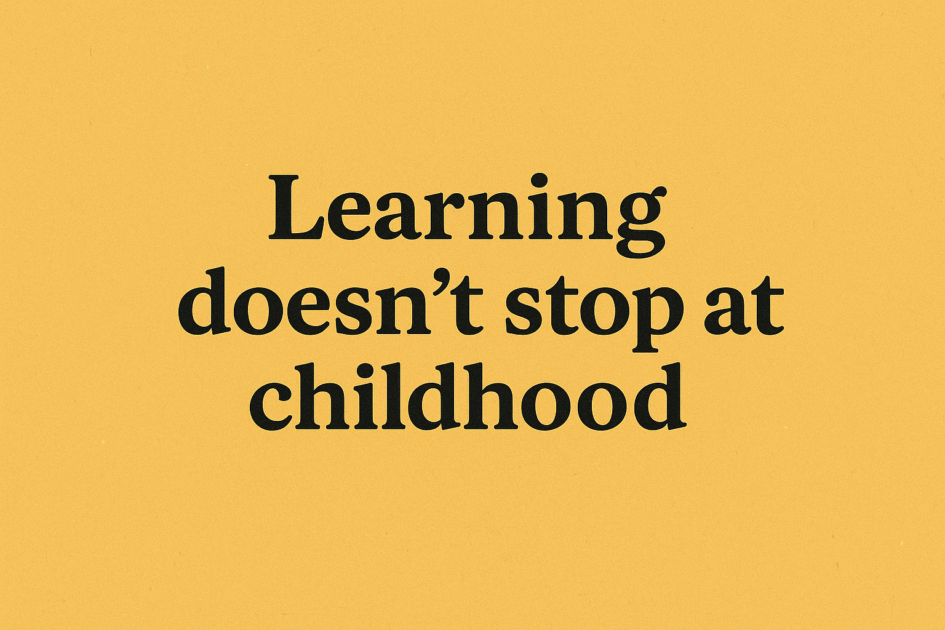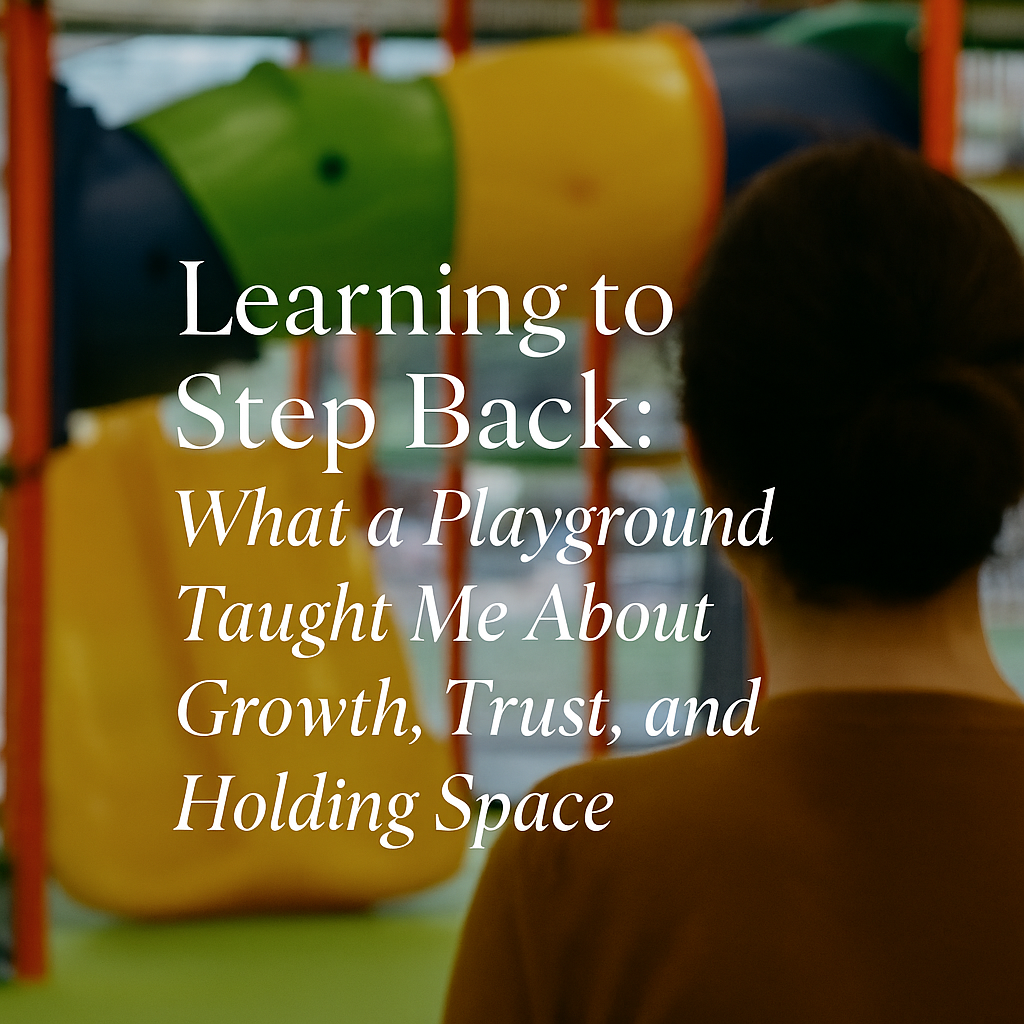I wasn’t planning to write a blog post about this. We just went to the indoor playground for some movement, connection, and toddler joy. But something stayed with me after we left. Not just the usual tired-but-happy kind of feeling, something deeper.
A question that kept echoing:
“What actually helps a child grow, and what gets in the way?”
And more importantly:
Are we, as parents, caregivers, and adults, learning alongside them or are we sometimes unlearning what they instinctively know?
This isn’t a how-to parenting article. It’s a reflection, one that began with my two-year-old’s confidence unfolding in a familiar play space… and led me to rethink the deeper meaning of presence, learning, and trust.
If you’ve ever wondered whether you’re doing too much or too little…
If you’ve ever felt unsure about when to step in and when to step back…
Or if you simply want to understand what early learning really looks like from the inside out, then this story is for you.
The Playground Setup That Made Me Reflect
We were at a familiar playground, one my toddler already knew.
He’d been there before. He recognized the colorful slides, the padded stairs, the climbing nets, and the tunnels. But this time, something clicked more quickly.

He saw a few of his little friends already inside and walked toward them, more confident than usual. He didn’t rush in immediately, that’s not how he approaches new or busy environments. He tends to observe first, assess what’s happening, scan who’s there, and then take a few steps forward. He usually invites me to join him at that stage, staying close, often holding my hand, until he finds his rhythm.
But here, the space was already familiar. The activities were predictable. And most importantly, he felt safe, not just because I was there, but because the environment felt known. It’s in moments like this that I notice how learning builds in layers. The first time might be about exposure. The next, about comfort. And eventually, about mastery and interaction.
What stood out to me wasn’t just how he played, but how the space was designed to allow him to play without me.
The layout naturally encouraged independent movement, exploration, climbing, and peer interaction, all while I stayed close by, but not involved.
That contrast made me pause.
It’s not always easy (or even common) to find spaces that support this kind of autonomy for toddlers while still holding a safe and visible connection to the parent. But this place managed to do both.
And it sparked a reflection that’s been with me since:
How much learning actually happens when we step back not out of disconnection, but out of trust?
Movement Before Words And How Toddlers Learn Through Play
One of the most overlooked aspects of early learning is just how much happens before children even start speaking in full sentences.
We tend to associate learning with things we can measure: letters, numbers, colours, or shapes. But for toddlers, the real learning foundation is being laid quietly, through movement, sensory exploration, and physical interaction with their environment.
Climbing, crawling, spinning, sliding, bouncing — these aren’t just ways to burn energy.
They are the brain’s way of wiring essential systems.
Every time my child climbs a padded ladder, squeezes through a tunnel, or dives into a pool of balls, he’s not just playing, he’s engaging in a full-body learning experience.
These kinds of movements aren’t random. They’re essential.
Here’s what’s actually being built behind the scenes:
- Motor development supports cognitive development.Gross motor activities like climbing or balancing challenge the brain to coordinate limbs, predict movement, and adapt in real-time. These are executive function skills in disguise.
- Repetitive movement helps build neural pathways.The more a child repeats a physical action, the more those brain circuits are strengthened. It’s how habits of learning, focus, and even emotional regulation begin to form.
- Vestibular and proprioceptive input build body awareness and attention.Slides, swings, and ball pits all offer sensory feedback that helps toddlers understand where their body is in space: a key ingredient in developing balance, coordination, and self-regulation.
- Risk assessment begins here.Even small acts like deciding whether to go up the steps, how high to climb, or when to jump into the ball pit are early forms of judgment, planning, and decision-making.
What I am mentioning here, there theories, they aren’t abstract theories, they’re visible in every playground if you pay close attention.
You can see the processing happening.
The pause before stepping onto a moving platform.
The negotiation between two toddlers about who goes down the slide first.
The problem-solving required to figure out how to get from one level to another.
It’s learning, but without a worksheet or a whiteboard. A learning that we‘re not used to recognise, because we rarely or never saw it.
What struck me most was that none of this required me to explain anything.
Not because I don’t have a role in his learning, but because in that moment, his body was the teacher. The environment was the classroom. And my presence was the safety net. Nothing more, nothing less.
The Power of Being Nearby, Not Inside Their Experience
One of the things I appreciated most about this playground was how it was built.
Not just for kids, but intentionally not built for adults.
There were corners I couldn’t fit into, tunnels I couldn’t follow him through, and levels I couldn’t climb without disrupting the flow of play. At first glance, it might seem inconvenient. But in reality, it was brilliant.
Because it allowed him to lead his own experience, while still knowing I was right there.
There’s a very specific kind of learning that happens when a child senses safety but doesn’t rely on constant intervention. It’s not abandonment. It’s not detachment. It’s what many early childhood educators call proximal presence. You’re near, but not in the middle. Available, but not directing.
In my case, I wasn’t sitting inside the ball pit or following him up the padded stairs.
But I was always somewhere within sight. And every now and then, he would glance at me, to check, to anchor, to reconnect. Then he’d go back to playing.
That’s what trust looks like at this age.
It’s not about independence in the adult sense. It’s about a secure attachment that gives them the confidence to explore without fear.
Because they know that I haven’t left the room. I’m just not in the way.
And I’ve come to see that this kind of space design actually teaches the parent too.
It shows us what stepping back can look like without stepping out.
It invites us to hold space, not with our hands, but with our presence.
This isn’t always easy to explain, especially when we’re surrounded by cultural messages that equate “good parenting” with being constantly involved. But in reality, the subtle decision to not intervene is a form of care. So is waiting. So is letting them try before offering help.

When Our Care Gets in the Way of Their Growth
This is where things get a bit more uncomfortable and not because it’s wrong to care, but because care can sometimes become control when we don’t realize we’ve crossed that line.
It’s easy to spot overparenting in theory, but in practice, it’s much more subtle.
Sometimes it looks like insisting we go down the slide with them “just in case.”
Sometimes it’s correcting how they’re climbing, even when they’re not in danger.
Sometimes it’s stepping in too soon to “help” when what they really need is a bit more time and space to figure things out on their own.
And sometimes, it’s less about action and more about direction.
The constant guiding: “Do you like that one?” “Wanna try this?” “Go there, look here!”
All the questions and prompts that keep the child externally focused instead of tuned in to their own curiosity.
To us, it might feel like we’re involved, like we’re being present, we’re supporting and that we’re connecting. But in spaces like this, that kind of involvement can actually pull them out of the experience.
They don’t need us to narrate their play. They need the space to be in it fully, freely, and without performance.
I’ve noticed how easy it is to fall into that dynamic, especially when other adults are around.
Because truthfully, one of the most challenging parts of parenting in public isn’t the child. It’s the gaze.
The sideways looks. The silent judgments. The subtle discomfort others show when you’re not micromanaging your child.
But being outside the play area (physically) is not the same as being an outsider in their experience.
I’m not detached. I’m not disconnected. I’m reading him. I’m timing my involvement. I’m holding the space.
That’s the difference.
Because there are also moments when he does need me, and in those, I’m fully there.
Like the time he wanted to ride a specific little car that was already taken by another child. He waited and watched. Then, just as it became free, someone else grabbed it right before him. His face dropped. He cried. He turned to me. Not for rescue, but for support.
I didn’t rush to fix it. I didn’t try to distract him or negotiate with the other child.
I simply sat down next to him and explained: “Yes, I see that you’re sad. You were really hoping to ride that car. It was taken again, and that feels hard.”
We talked about waiting. About how sometimes we don’t get what we want right away.
And how we could either explore something else while we wait or just wait, if that’s what he needed.
That moment wasn’t about the car. It was about processing disappointment, feeling seen, and learning that emotions can move through us even if things don’t go our way.
And that’s the difference.
Not interfering, but anchoring.
Not fixing, but staying present.
Not managing the situation, but supporting him in managing himself.
This kind of discernment isn’t taught in most parenting books because it doesn’t come with a checklist. It comes from attunement and from trusting that sometimes, stepping back isn’t neglect.
It’s a form of deep respect.

This Isn’t Just About Childhood, It’s About How We All Learn
What struck me most after we left that day wasn’t just how much my child had learned in the span of an hour. It was how familiar it felt to me, as someone who spends her free time planning, imagining and designing learning experiences that facilitate and invite learning to take place, instead of inhibiting it.
Because in many ways, that’s how learning still happens for all of us.
We observe before we act.
We explore before we understand.
We try. We fail. We cry. We try again.
And we grow. Not because someone gave us all the answers, but because we had space, safety, and support to figure it out in our own way.
But somewhere along the way, we confuse learning with schooling.
We think learning means sitting still, listening, following instructions, or getting it right the first time.
We forget that real learning is messy. Physical. Emotional. Personal. And it happens best when we feel safe enough to try without the fear of being judged or rushed.
That’s true for children, you may think. But, I’m telling you that it’s also true for adults navigating a career shift, for new parents, for someone learning to trust themselves again after burnout or loss.
The same elements apply: Presence. Patience. Permission to not get it right immediately.
We never outgrow the need for those conditions. We just stop being given them so freely.
And maybe that’s the quiet invitation here: to remember that learning doesn’t stop at a certain age. But the environment we need to support it? That needs to be chosen intentionally.
Just like that playground was built to give my toddler space and structure, we also need spaces that support our adult learning, emotionally, physically and mentally.
Not with pressure. Not with perfection.
But with trust.
When I reflect on that playground, I don’t just think of padded slides and colourful balls. I think of all the invisible things that were being built in that space: Trust. Self-awareness. Emotional regulation. Autonomy. And not just for him, but for me too.
That’s what real learning looks like. It’s not always about teaching something new. Sometimes, it’s about getting out of the way so the learning can unfold naturally.

4 responses to “Learning to Step Back: What a Playground Taught Me About Growth, Trust, and Holding Space”
Loved the depth of information in this article—very helpful!
You completed certain good points there. I did a search on the theme and found a good number of persons will agree with your blog.
Great blog here! Also your website loads up very fast! What web host are you using? Can I get your affiliate link to your host? I wish my web site loaded up as quickly as yours lol
Hey there, thanks! I’m using hostinger, I switched to them recently and it was the best. Here’s a referral link: https://hostinger.pt?REFERRALCODE=WBRMONICAGHH